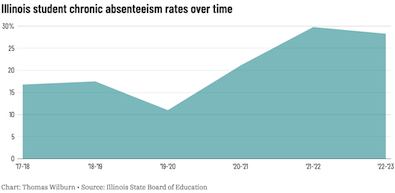
Latest Post | Last 10 Posts | Archives
Previous Post: Bailey continues touting Trump ties while Bost struggles to keep up
Next Post: SUBSCRIBERS ONLY - A look back and ahead
Posted in:
* ChalkBeat Chicago on the Illinois State Board of Education’s latest school report card…
About 28% of students were chronically absent from school last year. That’s a slight decrease — about a 1.5 percentage point — from the 2021-22 school year when about 29.8% of students were chronically absent.
Students are considered chronically absent when they miss about 18 days, or 10% of school, with or without a valid excuse. Student mental health days also count towards chronic absenteeism.
When students miss a significant amount of school it can impact their academic performance.
The report card shows high rates of absenteeism among Black, Native American, and Latino students. But Black, Latino, Asian American, and white students also saw improvement in school attendance compared in 2021-22. During last school year, chronic absenteeism rates were high among students from low-income families, students experiencing homelessness, and students with Individualized Education Programs.
The Illinois data is similar to what schools are seeing across the country. Attendance Works — a nonprofit organization that looks into attendance rates across the country — has seen early data from 11 states that found about 27.9% of students were chronically absent during the 2022-23 school year — a 2.2% decrease in chronic absenteeism rates compared with the 2021-22 school year.
* Chart…

* From the ISBE…
Chronic absenteeism, which skyrocketed during the pandemic, improved modestly in the 2022-23 school year, dropping from 29.8% to 28.3%. Black students, who saw the greatest increase in chronic absenteeism during the pandemic due to having disproportionately less access to in-person instruction, saw the greatest year-over-year improvement. While headed in the right direction, chronic absenteeism remains alarmingly high.
ISBE has dedicated $12 million to Regional Offices of Education to combat absenteeism and more than $100 million for Community Partnership Grants that are designed to improve mental health, regional Social-Emotional Learning Hubs, and programming to support trauma-responsive practices in schools.
Also, one thing that might help is if ISBE fixes its bungling of the after-school program.
posted by Rich Miller
Monday, Oct 30, 23 @ 11:52 am
Sorry, comments are closed at this time.
Previous Post: Bailey continues touting Trump ties while Bost struggles to keep up
Next Post: SUBSCRIBERS ONLY - A look back and ahead
WordPress Mobile Edition available at alexking.org.
powered by WordPress.
=ISBE has dedicated $12 million to Regional Offices of Education to combat absenteeism and more than $100 million for Community Partnership Grants=
Mostly wasted money.
=one thing that might help is if ISBE fixes its bungling of the after-school program.=
Might help, but not much if at all.
Listen, if the state was actually really concerned about this, they wouldn’t have taken away the few tools we had to deal with it. Courts do not enforce the few laws enacted to address serious truancy. Truancy officers have zero authority and schools have even less.
We battle negligent parents and kids who are emboldened because there are no immediate consequences with words and our ability to persuade. And that is about it. The real consequence is not getting an education and the lifelong effects that creates. But businesses all over the state hire these kids so they have access to money however short sighted that is.
Comment by JS Mill Monday, Oct 30, 23 @ 1:37 pm
I think there’s a big difference between chronic absenteeism and chronic truancy. My nephew would have often been rated chronically absent. He was suffering from a heart defect that frequently kept him out of school. He had a big challenge just surviving (unfortunately he lost that battle at 16 years old) and education was not really the top priority–it was a priority, the kid was curious about his world and dreamt of being a paleontologist.
So if you take out the chronically ill students, how much chronic absenteeism is left, and what are the causes? Students working to bring money to family? Bored students who don’t care? Families that are so disfunctional they can’t get the kid to school? Different tools would be needed for different groups.
Comment by cermak_rd Monday, Oct 30, 23 @ 2:13 pm
@cermak_rd:
The ISBE site lists chronic truancy numbers separate from chronic absenteeism. “Chronic truant” means a student missed 5% or more school days with no valid excuse. Here are the chronic truant rates for the last three years:
2021: 22.8%
2022: 22.1%
2023: 19.9%
There is a stark racial gap in chronic truancy rates. In 2023, the rates as listed by ISBE were:
White: 7.7%
Black: 44.7%
Hispanic: 27.9%
Asian: 7.9%
American Indian: 27%
Pacific Islander: 19.7%
Two or More: 17.6%
The chronic absenteeism rate only dropped by 0.5% among white students last year, while it dropped by nearly 6% among black students. The chronic truancy rates saw similar reductions among those demographic groups (0.9% and 5.5% respectively).
Comment by Skokie Man Monday, Oct 30, 23 @ 3:08 pm